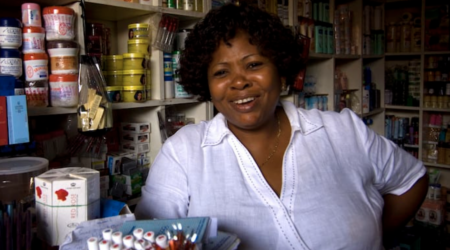5 Barriers Holding Back Fintech Entrepreneurs

There are a growing number of financial technology companies starting up across the globe in an effort to find ways to harness technology to reach underserved or unserved customers. While financial inclusion presents both a development and a business opportunity, there are challenges that constrain the ability of this cadre of entrepreneurs.
“What’s exciting is technology is reinventing the financial services landscape,” said Colleen Briggs, executive director of community innovation within the Office of Corporate Responsibility and Global Philanthropy at JPMorgan Chase.
Briggs added that as data improves, more profitable, affordable products that meet people’s needs can be created and delivered. In fact, Briggs said fund managers were saying that they couldn’t get enough deals and there was a mismatch in the market. However, despite a lot of investment supporting financial inclusion, there are serious gaps, particularly for organizations focused on low-income populations.
To help address part of the funding gap, JPMorgan and the Bill & Melinda Gates Foundation launched the Catalyst Fund in 2016. Impact investors help identify innovations or companies that are not yet investment ready — those companies get derisking grant capital through the fund and customized technical assistance. It is that customized help that sets the fund apart from many accelerators or incubators, which often focus on more general business skills.
The Catalyst Fund has funded 15 companies in emerging markets, and is now announcing a new cohort of grantees. They are Abalobi, an app working on social justice and poverty alleviation in small-scale fisheries; Asaak, which provides mobile-based credit to African entrepreneurs and farmers; MobiLife, a mobile life insurance company; Rukula, a company working to help people access credit for household goods and electronics; and ToGarantido, which provides affordable insurance to low-income customers.
But getting funding is just one challenge. There are a number of other obstacles facing fintech entrepreneurs, from finding the right technology and building trust with customers, to regulatory barriers. Below, Devex looks at five key barriers holding back fintech entrepreneurs.
1. The regulatory environment
Regulations often hamper the fintech industry, which has to abid by financial rules and often other sectoral rules as well if the company sells a product such as insurance, for example. While regulations are critical to protecting customers, they can slow the adaption of new technologies and create barriers to access for the underserved.
“There’s a lot of red tape,” said Jonathan Duarte, chief executive officer of Escala Educación, a company that provides employer-matched education savings accounts in Colombia. “Since it’s a highly regulated industry you don’t want to step over any lines … What that means for us is we have to be continuously developing processes, trying new things to be on the right side of regulation, make it efficient and reach customers that have been underserved for a long time.”
Another challenge is working with financial institutions, Duarte said. It can often take a year to sign an agreement with a bank, which is “only the beginning of the struggle,” because executing those deals “can be very painful,” he said. Escala has had to diversify its financial partners because some haven’t always been able to respond with what they need to serve their customers, he said.
While regulations are in place because past incidents exposed people to getting hurt by bad players in the industry, more friendly legislation could help how they serve low income customers, he said.
In Colombia, for example, opening an account often requires a physical signature, which is something that can make it harder to bring in low-income customers. Changes to those types of law could make it easier to grow and reach those customers, and Duarte is watching for new fintech regulations, which may be on the horizon.
There is often a tension between regulation and the acceptance of innovation in emerging markets, said Chris Sheehan, co-founder and CEO of WorldCover, a company that sells crop insurance to small-scale farmers in several African countries.
“Often there’s a conservative bias in many of these regulators,” he said, adding that while that is true in developed markets as well, it is often more pronounced in developing countries.
“It just creates a difficult environment when you need approval from regulators at every step,” Sheehan said. Sometimes it results in a circular situation in which the company goes in and says that it wants to try to test a new product or system but they are not allowed to do so because they don’t have approval, but they can’t get approval without market evidence, which they can’t get without testing.
For WorldCover there is an additional regulatory burden because with crop insurance it has to seek approval from every state and country. While some regulators embrace the idea, it is sometimes difficult to convince authorities about why it is important, he said. Sometimes, regulators will say they have to commit to bringing $1 million into the country, which is a significant barrier to entry.
That’s where the development community, particularly big donors, can help, Sheehan said. They can help educate people about new products and “support regulators to ultimately help them create the right frameworks and attitudes that allow innovation and new ideas to come into the market, whether they are generated by local or external companies,” he said.
2. Funding
The perennial challenge for any entrepreneur, funding can be especially challenging for innovative fintech companies who are still developing their product and identifying their market.
A lack of angel investors in many developing countries and United States investors reluctant to invest in emerging markets is further exacerbating the challenge, Briggs said.
Facing a lack of risk capital in their countries, emerging market entrepreneurs are looking to a combination of grants and investments to seed, derisk, and scale up their startups. Devex explores how blended capital could be the key ingredient to bursting through the “missing middle.”
Attracting traditional Silicon Valley investment is one of the biggest challenges, Sheehan said. Sheehan, who has been through the valley’s famous Y Combinator accelerator has had a first hand look at the issue. Many “roboadviser” or “copycat” companies in the U.S. get investments, but some of the Catalyst Fund companies doing unique things in Latin America or Africa find it “just really hard to get Silicon Valley VCs to understand markets and take the risk of funding them, sadly a lot don’t get the resources they need,” he said.
While WorldCover has been fairly successful, Sheehan has also encouraged the Catalyst Fund to expand its investor circle so that companies can more easily access potential investment down the road.
A lot of venture capital or donor money is going into some industries, such as pay-as-you-go solar, that don’t need it because they already have a proven business model, but it is a sure bet and it is clear what the impact of the investment would be, Sheehan said.
Donor programs “should almost be the riskiest type of capital, it could unlock business models,” but it isn’t structured in a way that makes that possible, he said. Donors often require a lot of evidence, existing traction, and a lot of accountability, some of which isn’t available at the early stages of a company, Sheehan said. It’s hard to justify the investment in creating relationships and understanding the request for proposal rather than telling a business story to investors, which is often a faster route to capital, he added.
3. Technology
Figuring out the right technology, both for the customers and for the company, can be tricky for some fintechs, and will often evolve as the company develops its product and responds to consumer needs.
CEOs of fintech companies are not always technology experts, and finding the right size and cost technology system is important, said David del Ser, the director of inclusive fintech at BFA, a global consulting company focused on “using finance to create solutions for low-income people.”
Some companies that del Ser has worked with aren’t sure what technology to invest in and sometimes look to use technology or platforms that are more expensive and powerful than what they need, he said. BFA works with them to build quick, scalable technology systems, he said.
Companies are also often generating data, but many of the Catalyst companies weren’t making effective use of the data, or figuring out what would be best to collect to help achieve their goals and improve their products, del Ser said.
Different technologies are also needed in different geographies. In Latin America, for example, more companies are basing their services on users having smart phones, whereas in Africa, where fewer people have smartphones, companies must be able to provide a product using basic phones. In Brazil, a company that used a chatbot to interact with prospective clients worked, but when a similar system was tried in South Africa, it failed, in part because not enough potential clients had smartphones.
For some of the companies that didn’t have good backend technology, BFA worked to help set them up with first step tools such as Google Sheets, rather than jumping to a system such as Salesforce, which might be more than a startup needs.
For companies that had data, BFA helped them to use the data more effectively and employ machine learning algorithms to help their processes, he said.
4. The human element
Technology alone is often not enough. Some of the companies in the Catalyst Fund have found that having a human element, perhaps at the sales point, or elsewhere in the process is critical to customer acquisition and retention Briggs said. While some companies had initially planned to have an entirely digital customer interaction, they had to switch strategies and incorporate more human interaction, she said.
Fintech companies often need help with user research, understanding their customers’ needs, and how to develop a product that fits their needs. Especially in early stages, fintechs are asking for more support to understand both users and product-market fit, Briggs said.
5. Building trust
When banking and financial services relied on a relationship with a physical institution, it was easier to build trust with customers, but fintech companies often struggle to build trust and loyalty through a digital platform, Briggs said.
This was a challenge many Catalyst Fund companies faced, so it developed a new toolkit about how to build trust on a digital platform at key moments, from acquisition to customer service, she said. In the the next few months it will also release information looking at the behavioral economics around building trust, Briggs said.
“Companies must ensure products are designed to met the needs of consumers and are building trust at each stage of the customer journey,” she said.
Several of the Catalyst Fund companies have had to adapt their strategies and go from a fully digital operation to including in-person contact at certain phases of their sales process in order to build that trust.
“Something that we’re seeing is that as these companies go digital, they definitely encounter challenges in the creation of trust,” said David Del Ser. With microfinance institutions, borrowers would typically see a loan officer before receiving a loan, which helped build trust, but isn’t convenient and can constrain access.
A number of companies have struggled to create trust, for example in an insurance product, when they maybe see a customer only once in their relationship, he said.
(Originally published on Devex)

